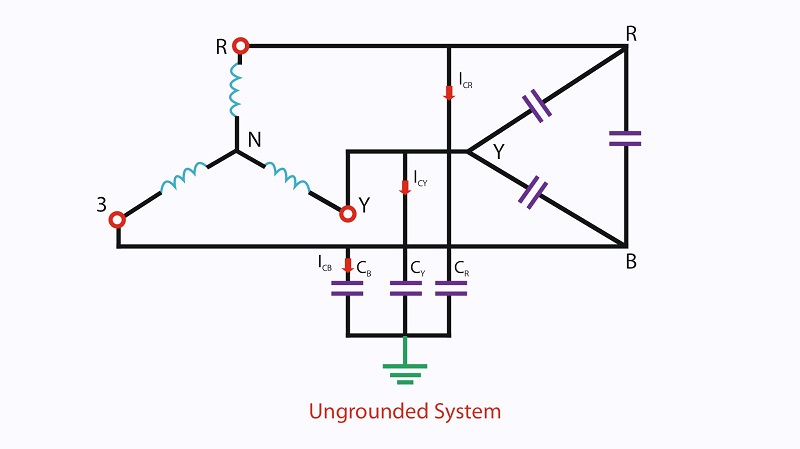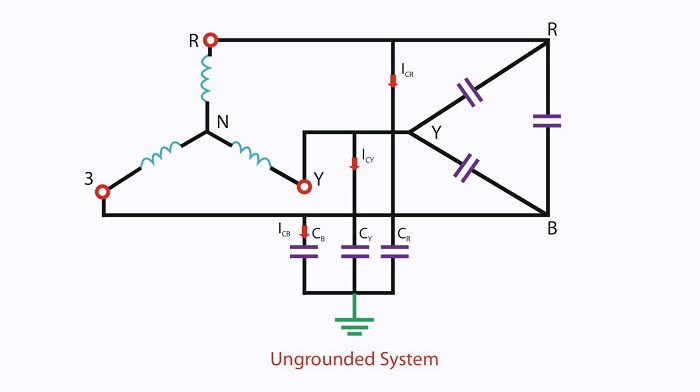A grounding system is a network of conductors that provides a low-impedance path for electrical fault currents to flow safely to the earth. The purpose of a grounding system is to protect people and equipment from electrical hazards, such as electrical shock and equipment damage. In an electrical distribution system, the grounding system is typically connected to the earth at the service entrance and at various points throughout the system to provide a continuous path for fault currents to flow.
Grounding systems can come in different types, including ungrounded, resistance grounded, and solidly grounded systems. Proper grounding is essential for the safe and reliable operation of electrical distribution systems. In this blog, we shall explore all the 3 systems.
Ungrounded System
Ungrounded systems are power systems with no intentionally applied grounding. However, they are grounded by the natural capacitance of the system to the ground.
This type of system is not commonly used because it does not provide a low-impedance path for fault currents to flow. However, ungrounded systems can be used in special applications where continuity of service is critical, such as in hospitals or data centres.

The lack of a direct path to ground in an ungrounded system makes it difficult to detect and isolate ground faults. Ground faults can cause voltage surges, resulting in equipment damage or electrical shock. Therefore, special protection devices are required to detect and isolate faults in ungrounded systems. These protection devices can be expensive, and the troubleshooting of ground faults in ungrounded systems can be challenging. Have a look at our Grounding Materials that will help you ensure electrical safety.
One of the main advantages of an ungrounded system is that it can help prevent disruptions in critical applications where continuity of service is essential. Ungrounded systems are also less susceptible to nuisance tripping, which can occur in grounded systems due to transient voltage surges.
Due to their high level of complexity, ungrounded systems are not suitable for most general applications, and solidly grounded or resistance grounded systems are typically used instead.
Resistance Grounded System
It is a type of grounding system in which one conductor is intentionally connected to the earth through a resistor. The resistor limits the fault current that flows to the ground, which can help prevent equipment damage and reduce the risk of electrical shock. The resistance value is typically selected to limit the fault current to a safe level while still allowing protective devices to detect and isolate faults.
Resistance grounding is commonly used in low-voltage systems, such as 480V and lower, and in some medium-voltage systems. It is particularly useful in systems where a low level of fault current is desired to prevent damage to equipment or to minimize the risk of electrical shock. For example, in a fault condition, a resistance grounded system will limit the current flowing through a faulted piece of equipment to a safe level and reduce the likelihood of thermal damage.

One disadvantage of resistance grounding is that it can complicate the detection of a fault, making troubleshooting more difficult. Special relays and monitoring equipment are required to detect ground faults in resistance grounded systems. Despite this, resistance grounding is a popular option for many low-voltage and medium-voltage applications and is considered a safe and effective way to protect equipment and personnel.
Want to know our price?
Solidly Grounded System
In this type of grounding system, one conductor is directly connected to the earth without any intentional resistance. In a solidly grounded system, the fault current flows directly to the ground, which can cause a high level of fault current and damage equipment. However, this type of grounding is the most common in medium and high-voltage systems because it provides a low-impedance path for fault currents to flow, allowing protective devices to quickly detect and isolate faults.
Solidly grounded systems are generally considered the simplest and most economical type of grounding system. They are also the most reliable, as they provide a direct path to the ground for fault currents. However, solidly grounded systems can produce a high level of fault current, which can cause significant equipment damage and pose a risk to personnel. For this reason, solidly grounded systems are usually protected by ground fault detection and protective devices, such as ground fault relays and circuit breakers.

Solidly grounded systems are used in a wide range of applications, including power generation, transmission, and distribution systems, industrial and commercial facilities, and other high-voltage installations. They are preferred for their simplicity, reliability, and cost-effectiveness in high-voltage applications. However, they may not be suitable for applications where minimizing equipment damage or personnel risk is a higher priority than continuity of service.
Conclusion
Grounding systems are essential for the safe and reliable operation of electrical distribution systems. They provide a low-impedance path for fault currents to flow and protect people and equipment from electrical hazards. Grounding systems can come in different types, each with its own advantages and applications, including ungrounded, resistance grounded, and solidly grounded systems. While each type has its own benefits and drawbacks, solidly grounded systems are the most common and economical type of grounding system used in medium and high-voltage applications due to their simplicity, reliability, and cost-effectiveness. However, proper protection devices are required to detect and isolate faults and reduce the risk of equipment damage and personnel injury.
I hope you now have a clear idea about all the 3 grounded systems. At Axis, we have a team of 40+ engineers who are here to help you in designing, installing and testing your Grounding Systems. Our products have been used in substations, data centres, factories and even in everyday residential and commercial buildings.
Thank you for reading the blog, Axis is a leading manufacturer and supplier of AB Cable Accessories and other Electrical Components to over 80+ Countries. To get a quote or to talk to our industry expert visit our contact us section. You can also watch our videos by our experts – click here.








